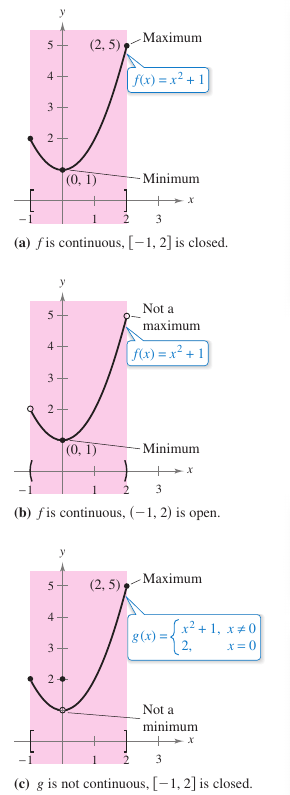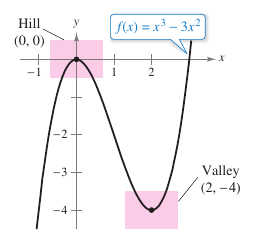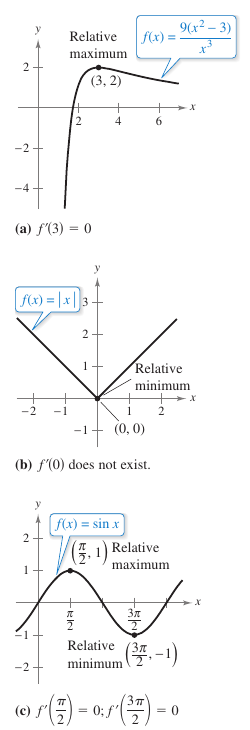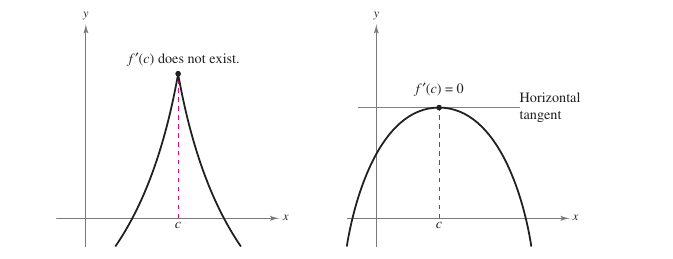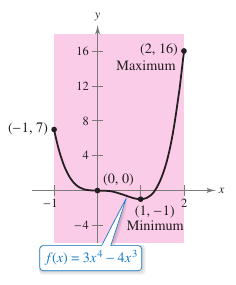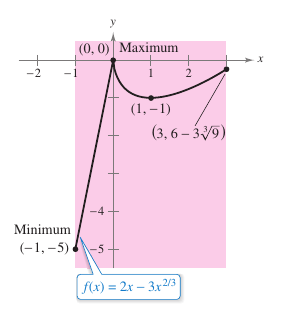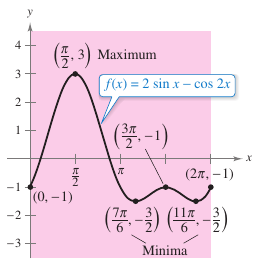Calculus I 03.01 Extrema on an Interval
| Previous | Calculus I 02 Differentiation |
| Next | Calculus I 03.02 Rolle’s Theorem and the Mean Value Theorem |
Contents
3.1 Extrema on an Interval
- The definition for extrema function on an interval.
- The definition for relative extrema function on an open interval.
- Find extrema on a closed interval.
|
|
Extrema for a FunctionCalculus studies the how a function \(f\) behaves on an interval \(I\). Questions arise as to what is the maximum? Minimum? Where is the sharpest increase? The steepest decrease? This is called bounds checking or finding the extremes in a problem. This is called finding the extrema and has many applications in the real-world. Definition 3.1.1 ExtremaLet \(f\) be defined on an interval \(I\) containing \(c\). A function need not have a minimum or a maximum on an interval. For example, Figure 3.1.1(a) and (b), show the function \(f(x)=x^2+1\) has both a minimum and a maximum on the closed interval \([-1,2]\), but does not have a maximum on the open interval \((-1,2)\). Figure 3.1.1(c), shows the continuity, or the lack, can affect an extremums existence on the interval. This suggests Theorem 3.1.1 below. Theorem 3.1.1 The Extreme Value TheoremIf \(f\) is continuous on a closed interval \([a,b]\), then \(f\) has both a minimum and maximum on the interval. |
Relative Extrema and Critical Number
|
|
Informally, for a continuous function, the relative maximum occurs on a “hill” on the graph, and a relative minimum occurs in a “valley” on the graph. Such a hill and valley can occur in two ways. When the hill or valley is smooth and rounded, the graph has a horizontal tangent line at the high point or low point. When the hill or valley is sharp and peaked, the graph represents a function that is not differentiable at the high point or low point. Definition 3.1.2 Relative Extrema
The plural for relative maximum is relative maxima. The plural for relative minimum is relative minima. Relative maximum and relative minimum are sometimes called local maximum and local minimum, respectively. Example 3.1.1 examines the derivatives for functions at given relative extrema. Section 3.3 describes finding relative extrema. Example 3.1.1 Derivative Value at Relative ExtremaFind the derivative value at each relative extremum shown in Figure 3.1.3.
At the point \((3,2)\), the value for the derivative is \({f}'(3)=0\), as shown in Figure 3.1.3(a).
c. The derivative for \(f(x)=\sin x\) is
At the point \((\pi/2,1)\), the value for the derivative is \({f}'(\pi/2)=\cos (\pi/2)=0.\) At the point \((3\pi/2,-1)\), the value for the derivative is \({f}'(3\pi/2)=\cos (3\pi/2)=0\), as shown in Figure 3.1.3(c). | |||||||||||||||||||||
Note in Example 3.1.1 that at each relative extremum, the derivative either is zero or does not exist. The \(x\)-values at these special points are called critical numbers. Figure 3.1.4 illustrates both types. Notice in Definition 3.1.3 the critical number \(c\) must be in the domain for \(f\), but \(c\) does not have to be in the domain for \({f}'\).
Definition 3.1.3 Critical Number
Let \(f\) be defined at \(c\). If \({f}'(c)=0\) or if \(f\) is not differentiable at \(c\), then \(c\) is a critical number for \(f\).
Theorem 3.1.2 Relative Extrema Occur Only at Critical Numbers
If \(f\) has a relative minimum or relative maximum at \(x=c\), then \(c\) is a critical number for \(f\).
Proof
Case 1: If \(f\) is not differentiable at \(x=c\), then by definition, \(c\) is a critical number for \(f\) and the theorem is valid.
Case 2: If \(f\) is differentiable at \(x=c\), then \({f}'(c)\) must be positive, negative, or 0.
Suppose \({f}'(c)\) is positive. Then
- $${f}'(c)=\lim_{x \to c} \frac{f(x)-f(c)}{x-c} > 0$$
which implies there exists an interval \((a,b)\) containing \(c\) such that
- $$\frac{f(x)-f(c)}{x-c} > 0, \text{ for all } x \neq c \text{ in } (a,b).$$
Because this quotient is positive, the signs for the denominator and numerator must agree. This produces the following inequalities for \(x\)-values in the interval \((a,b)\).
- \(c\) from Left: \(x<c\) and \(f(x)<f(c) \rightarrow f(c)\) is not a relative minimum.
- \(c\) from Right: \(x>c\) and \(f(x)>f(c) \rightarrow f(c)\) is not a relative maximum
The assumption that \({f}'(c)>0\) contradicts the hypothesis that \(f(c)\) is a relative extremum. Assuming that \({f}'(c)<0\) produces a similar contradiction, only one possibility is left, \({f}'(c)=0\). By definition \(c\) is a critical number for \(f\) and the theorem is valid.
Finding Extrema on a Closed Interval
Theorem 3.1.2 states that the relative extrema for a function can occur only at the critical numbers. The following guidelines describe how to find extrema on a closed interval.
Guidelines for Finding Extrema on a Closed Interval
To find the extrema for a continuous function \(f\) on a closed interval \([a,b]\) follow these steps.
1. Find the critical numbers for \(f\) in \((a,b)\).
2. Evaluate \(f\) at each critical number in \((a,b)\).
3. Evaluate \(f\) at each endpoint for \([a,b]\).
4. The least value is the minimum. The greatest is the maximum.
The next three examples apply these guidelines. Finding the critical numbers is only one part. Evaluating the
function at the critical numbers and the endpoints is the other part.
Example 3.1.2 Finding Extrema on a Closed Interval
|
|
Find the extrema for
on the interval \([-1,2]\).
To find the critical numbers for \(f\) in the interval \((-1,2)\) find all the \(x\)-values for which \({f}'(x)=0\) and for which \({f}'(x)\) does not exist.
Because \({f}'\) is defined for all \(x\) conclude that these are the only critical numbers for \(f\). Evaluating \(f\) at the critical numbers and at the endpoints produces the results shown in Table 3.1.1 below. The graph for \(f\) is shown in Figure 3.1.5.
| ||||||||||||||||||||||||||
In Figure 3.1.5, note that the critical number \(x=0\) does not yield a relative minimum or a relative maximum. This proves the converse for Theorem 3.1.2 is not true. In other words, the critical numbers for a function need not produce relative extrema.
Example 3.1.3 Finding Extrema on a Closed Interval
|
|
Find the extrema for
on the interval \([-1,3]\).
The derivative found two critical numbers on the interval \((-1,3)\). The number 1 is a critical number because \({f}'(1)=0\). The number 0 is a critical number because \({f}'(0)\) does not exist. Evaluating \(f\) at the critical numbers and endpoint produces the results shown in Table 3.1.2 below. The graph for \(f\) is shown in Figure 3.1.6.
| ||||||||||||||||||||
Example 3.1.4 Finding Extrema on a Closed Interval
|
|
Find the extrema for
on the interval \([0,2\pi]\).
Because \(f\) is differentiable for all real \(x\) find all critical numbers for \(f\) by finding the zeros for derivative. Considering \(2(\cos x)(1+2\sin x)=0\) in the interval \((0,2\pi)\), the factor \(\cos x\) is zero when \(x=\pi/2\) and when \(x=3\pi/2\). The factor \((1+2 \sin x)\) is zero when \(x=7\pi/6\) and when \(x=11\pi/6\). Evaluating the four critical numbers and both endpoints is shown in Table 3.1.3 below. The graph for \(f\) is shown in Figure 3.1.7.
| |||||||||||||||||||||||||||||
Internal Links
Parent Article: Calculus I 03 Differentiation Applications
